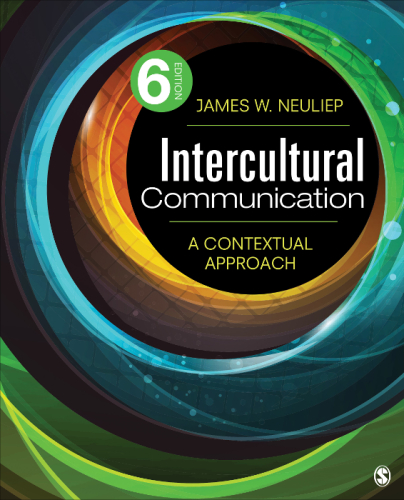Intercultural Communication: A Contextual Approach 6th Edition by James W. Neuliep, ISBN-13: 978-1452256597
[PDF eBook eTextbook]
- Publisher: SAGE Publications, Inc; Sixth edition (February 19, 2014)
- Language: English
- 528 pages
- ISBN-10: 1452256594
- ISBN-13: 978-1452256597
In this fully updated Sixth Edition of Intercultural Communication: A Contextual Approach, author James W. Neuliep provides a clear contextual model (visually depicted by a series of concentric circles) for examining communication within cultural, microcultural, environmental, sociorelational, and perceptual contexts. Beginning with the broadest context―the cultural component of the model―the book progresses chapter by chapter through the model to the most specific traits of communication― verbal and nonverbal messages. Each chapter focuses on one context and explores the combination of factors within that context, including setting, situation, and circumstances. Highlighting values, ethnicity, physical geography, and attitudes, the book examines means of interaction, including body language, eye contact, and the exchange of words, as well as the stages of relationships, cross-cultural management, intercultural conflict, and culture shock.
Table of Contents:
Preface to the Sixth Edition
1 The Necessity of Intercultural Communication
The Need for Intercultural Communication
Benefits of Intercultural Communication
Diversity in the United States
Human Communication
The Nature of Human Communication
Human Communication Apprehension
The Nature of Culture
Microcultural Groups
The Study of Intercultural Communication
Fundamental Assumptions About Intercultural Communication
The Ethics of Intercultural Communication
AN INTERCULTURAL CONVERSATION: WHERE SHOULD WE EAT DINNER?
Chapter Summary
Discussion Questions
Key Terms
Notes
2 The Cultural Context
Individualism–Collectivism
Individualism
Collectivism
Individualism Versus Collectivism?
So, Who’s an Individualist and Who’s a Collectivist?
AN INTERCULTURAL CONVERSATION: INDIVIDUALISTIC AND COLLECTIVISTIC CULTURES
Patterns of Individualism and Collectivism Across the United States
Communication Consequences of Individualism–Collectivism
Measuring Individualism–Collectivism
Vertical and Horizontal Individualism and Collectivism
The Pancultural Self
AN INTERCULTURAL CONVERSATION: THE PANCULTURAL SELF ON EXAMINATION DAY
High- and Low-Context Communication
Characteristics of High- and Low-Context Cultures
Communication Consequences of Low- and High-Context Cultural Orientations
AN INTERCULTURAL CONVERSATION: HIGH- AND LOW-CONTEXT CULTURES
Assessing High- and Low-Context Communication
Value Orientations
Schwartz Theory of Basic Values
Kluckhohn and Strodtbeck’s Value Orientations
Power Distance
Measuring Power Distance
Communication and Power Distance
AN INTERCULTURAL CONVERSATION: LARGE– AND SMALL–POWER-DISTANCE CULTURES
Uncertainty Avoidance
A Theory of Uncertainty Orientation
AN INTERCULTURAL CONVERSATION: WEAK AND STRONG UNCERTAINTY AVOIDANCE
Chapter Summary
Discussion Questions
Ethical Considerations Within the Cultural Context
Key Terms
Notes
3 The Microcultural Context
Microcultural Group Status
Muted Microcultural Groups
Microcultures in the United States
Hispanics/Latinos
African Americans
Asian Americans
Normative Communication Styles of African Americans, Asian Americans, and Hispanics/Latinos
The Hmong
The Amish
Lesbian, Gay, Bisexual, and Transgender Microcultural Groups
Chapter Summary
Discussion Questions
Ethical Issues and Microcultures
Key Terms
Notes
4 The Environmental Context
Environments and Information Load
Culture and the Natural Environment
Worldviews of the Natural Environment
Natural Disasters as Cultural and Social Events
The Built Environment
Cross-Cultural Comparisons of Housing
Japanese Housing
American Navajo Housing
Marakwet Housing
Privacy
Assessing Dimensions of Privacy
Perceptions of Privacy in the United States
Cross-Cultural Variations on Privacy
Online Privacy Across Cultures
Monochronic Versus Polychronic Time Orientation
Consequences of Monochronic and Polychronic Orientations
AN INTERCULTURAL CONVERSATION: MONOCHRONIC AND POLYCHRONIC CULTURES
Chapter Summary
Discussion Questions
Ethics and the Environmental Context
Key Terms
Notes
5 The Perceptual Context
Culture and Cognition
The Geography of Thought
A Model of Human Information Processing
Cross-Cultural Differences in Sensation and Perception
Cross-Cultural Differences in Memory and Retrieval
Categorization and Mental Economy
Stereotyping
Racial and Ethnic Stereotypes
American Stereotypes
Media Influence on Stereotypes
Stereotype Content Model
Why Stereotype?
Stereotypes and Expectations
AN INTERCULTURAL CONVERSATION: STEREOTYPING
Ethnocentrism
A Contemporary Conceptualization of Ethnocentrism
Ethnocentrism, Intercultural Communication, and Interpersonal Perception
Ethnocentrism and Communication in the Workplace
Ethnocentrism and Racism
Chapter Summary
Discussion Questions
Ethics and the Perceptual Context
Key Terms
Notes
6 The Sociorelational Context
Dimensions of Group Variability
Membership and Nonmembership Groups
In-Groups and Out-Groups
Reference Groups
Role Relationships
AN INTERCULTURAL CONVERSATION: STUDENT–TEACHER ROLE POSITIONS
Role Differentiation and Stratification
AN INTERCULTURAL CONVERSATION: CROSS-CULTURAL ROLE POSITIONS
Family Groups
Hmong
Korea
Israel
Mosuo
Sex and Gender Groups
Gender Stereotypes
Sex and Gender Roles Across Cultures
Japan
India
China
Mexico
Israel
Developing a Skill Set: Toward Intercultural Communication Competence
Chapter Summary
Discussion Questions
Ethics and the Sociorelational Context
Key Terms
Notes
7 The Verbal Code
The Relationship Between Language and Culture
Sapir–Whorf Hypothesis
The Structure of Human Language
Sounds and Symbols
Syntax and Universal Grammar
Universals of Language
Generative Grammar
Elaborated and Restricted Codes
Cross-Cultural Communication Styles
Direct and Indirect Styles
AN INTERCULTURAL CONVERSATION: DIRECT AND INDIRECT SPEAKING
Elaborate, Exacting, and Succinct Styles
Personal and Contextual Styles
AN INTERCULTURAL CONVERSATION: PERSONAL AND CONTEXTUAL SPEAKING
Instrumental and Affective Styles
AN INTERCULTURAL CONVERSATION: INSTRUMENTAL AND AFFECTIVE SPEAKING
Gendered Language Across Cultures
Language and Ethnic Identity
Do You Speak American?
Chapter Summary
Discussion Questions
Ethics and the Verbal Code
Key Terms
Notes
8 The Nonverbal Code
Definitions of Nonverbal Communication
The Relationship Between Verbal And Nonverbal Codes
Formal Versus Informal Code Systems
Channels of Nonverbal Communication
Kinesics
Occulesics
Paralanguage
Proxemics
Haptics
Olfactics
Physical Appearance and Dress
Chronemics
Nonverbal Communication and Dimensions of Cultural Variability
Individualism–Collectivism
Power Distance
High and Low Context
Nonverbal Expectancy Violations Theory
Cultural Contexts and Nonverbal Expectancies
AN INTERCULTURAL CONVERSATION: VIOLATION OF NONVERBAL EXPECTANCIES
Chapter Summary
Discussion Questions
Ethics and the Nonverbal Code
Key Terms
Notes
9 Developing Intercultural Relationships
Communication and Uncertainty
AN INTERCULTURAL CONVERSATION: UNCERTAINTY REDUCTION AND HIGH- AND LOW-CONTEXT
CULTURES
Anxiety/Uncertainty Management Theory of Effective Communication
Uncertainty Reduction and Intercultural Communication Apprehension
AN INTERCULTURAL CONVERSATION: UNCERTAINTY REDUCTION AND SOCIOCOMMUNICATIVE STYLE
Assessing Sociocommunicative Orientation/Style
Empathy and Similarity in Relationship Development
Empathy
Similarity
Perceptions of Relational Intimacy Across Cultures
Eastern and Western Cultures and Relationships
Interethnic and Interracial Relationships and Marriages
Intercultural Relational Maintenance
The Internet as Relational Maintenance
Japan
India
Korea
Mate Selection and Desirability Across Cultures
Arranged Marriages
Marital Dissolution and Divorce Across Cultures
Developing a Skill Set: Toward Intercultural Communication Competence
Chapter Summary
Discussion Questions
Key Terms
Notes
10 Intercultural Conflict
Definition of Intercultural Conflict
Kim’s Model of Intercultural Conflict
AN INTERCULTURAL CONVERSATION: KIM’S MODEL OF INTERCULTURAL CONFLICT
A Culture-Based Social Ecological Conflict Model
Intercultural Dialogue, Conflict Resolution, and a Culture of Peace
The Concept of Face, Facework, and Communication Conflict Styles
Face
Facework
Conflict Communication Styles
AN INTERCULTURAL CONVERSATION: DOMINATING AND THIRD-PARTY CONFLICT STYLES
The Intercultural Conflict Style Inventory
Individualistic and Collectivistic Approaches to Conflict
Conflict Resolution in High- Versus Low-Context Cultures
Chapter Summary
Discussion Questions
Ethics and Intercultural Conflict
Key Terms
Notes
11 Intercultural Communication in Business, Health Care, and Educational Settings
Intercultural Management
Management Practices Across Cultures
Japanese Management Practices
AN INTERCULTURAL CONVERSATION: CLASHING CULTURAL CONCEPTS ON THE JOB
German Management Practices
Mexican Management Practices
Chinese Management Practices
Culture, Intercultural Communication, and Health Care
Lay Theories of Illness
Health Care and Resources Across Cultures
Health Communication
Provider–Patient Communication
Intercultural Communication and Educational Settings
Learning Styles Across Cultures
Teacher Immediacy in the Classroom and Across Cultures
Some Recommendations for the Intercultural Classroom
Chapter Summary
Discussion Questions
Key Terms
Notes
12 Acculturation, Culture Shock, and Intercultural Competence
Acculturation
Acculturative Stress
A Model of Acculturation
Modes of Acculturation
Acculturation in the United States
Culture Shock
W-Curve Models of Reentry Culture Shock
Strategies for Managing Culture Shock
Indicators of Success in the Intercultural Context
Intercultural Communication Competence
A Model of Intercultural Competence
The Knowledge Component
The Affective Component
The Psychomotor Component
Situational Features
An Integrated Model and Measure of Intercultural Communication Competence
Chapter Summary
Discussion Questions
Key Terms
Notes
Glossary
Photo Credits
Index
About the Author
What makes us different?
• Instant Download
• Always Competitive Pricing
• 100% Privacy
• FREE Sample Available
• 24-7 LIVE Customer Support





